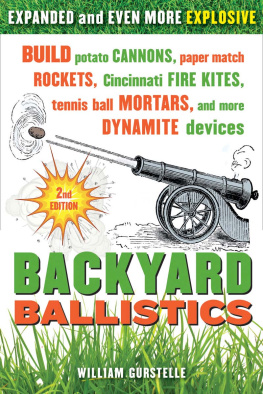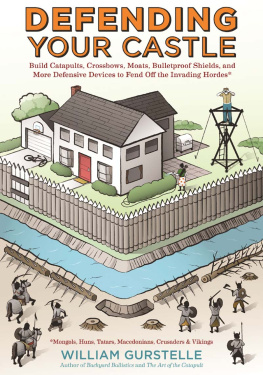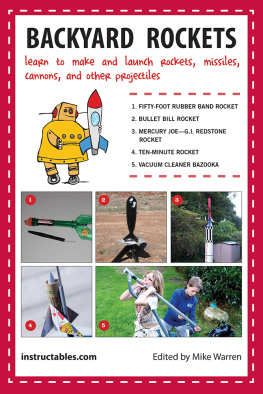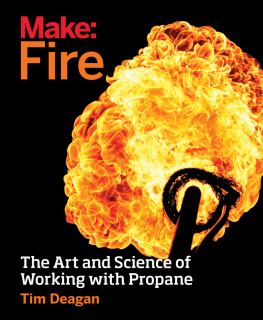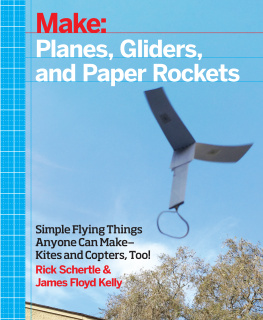

Copyright 2012 by William Gurstelle
All rights reserved
Published by Chicago Review Press, Incorporated
814 North Franklin Street
Chicago, Illinois 60610
ISBN 978-1-61374-064-4
Questions? Feedback? Updates? Visit www.Backyard-Ballistics.com
The Library of Congress has cataloged the first edition as follows:
Gurstelle, William.
Backyard ballistics : build potato cannons, paper match rockets, Cincinnati fire kites, tennis ball mortars, and more dynamic devices /
William Gurstelle.
p. cm.
Includes index.
ISBN 1-55652-375-0
ScienceExperiments. 2. BallisticsExperiments. I. Title.
Q164.G88 2001
531.55078dc21
2001017321
Cover design and interior layout: Jonathan Hahn
Interior design: Lindgren/Fuller Design
Illustrations: Todd Petersen and Rob Nance
Printed in the United States of America
10 9 8 7 6 5 4 3 2 1
This book is dedicated to my father,
Harold H. Gurstelle,
and my brother,
Steven M. Gurstelle
At other times, but especially when my uncle Toby was so unfortunate as to say a syllable about cannons, bombs, or petardsmy father would exhaust all the stores of his eloquence (which indeed were very great) in a panegyric upon the Battering-Rams of the ancientsthe Vinea which Alexander made use of at the siege of Troy.
He would tell my uncle Toby of the Catapultae of the Syrians, which threw such monstrous stones so many hundred feet, and shook the strongest bulwarks from their very foundationhe would go on and describe the wonderful mechanism of the Ballista which Marcellinus makes so much rout about; the terrible effects of the Pyraboli, which cast fire; the danger of the Terebra and Scorpio, which cast javelins
But what are these, would he say, to the destructive machinery of Corporal Trim? Believe me, brother Toby, no bridge, or bastion, or sally-port, that ever was constructed in this world, can hold out against such artillery.
Laurence Sterne,
The Life and Opinions of
Tristram Shandy, Gentleman

Contents
Acknowledgments
Thanks to Hank Childers, Frank Clancy, Steve Cox, Peter Gray, Brad Hansen, Randy Kuether, Dimitri Krattinger, Randy Tatum, Tom Tavolier, Clark Tate, the helpful friends of my sons who took special interest in creating this work, as well as many friends and relatives for their assistance and encouragement. Todd Keithley and Jane Dystel at Dystel and Goderich Literary Management deserve special recognition for making Backyard Ballistics a reality. Special thanks to my wife, Karen, and my sons, Andy and Ben, for their help and inspiration.
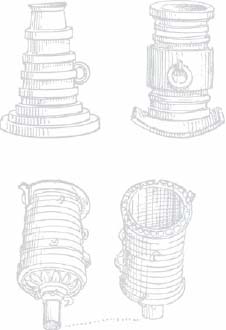
Preface to the Second Edition
Even as I invested nearly all my spare time writing Backyard Ballistics in 1998 and 1999, I wasnt terribly optimistic that I would find a publisher. At the time, projects and experiments like these were considered too edgy, too dangerous to describe in a book that just anybody could buy. There were a few publisher rejection letters telling me, more or less, that I was crazy to attempt publishing such material.
But I got some help from some wonderful and influential colleagues, caught a break or two, and basically, just kept at it. Backyard Ballistics was published and has since sold hundreds of thousands of copies.
In the ten or so years since the book first hit bookstore shelves, I have received countless e-mails and letters from people all over the world telling me how much they enjoyed the book. In some cases, letter writers told me that the book made a profound impression on them, so much so that it contributed significantly to their choice of science as a career. Nothing could make me so glad.
A lot has changed since the book was first published. There is a wider selection of project materials to choose from and more places than ever to obtain them. The Internet has made it much easier for experimenters to procure all sorts of raw materials and tools that were once hard to find. Best of all, theres a new interest in DIY science, and lively communities of enthusiastic builders, both real and virtual, have taken hold. This is due in no small part to media like Make and Popular Mechanics, magazines where I am proud to be listed as a contributing editor.
This newly revised second edition of Backyard Ballistics includes all the great projects from the original edition, but updates them to make them even better. The original spark igniter Potato Cannon is still here of course, plus youll find a new model using a different ignition system as well.
Pnewtons Petard, a.k.a. the compressed air cannon, has been thoroughly reworked. Its easier to build and far more accurate than before.
The Cincinnati Fire Kite remains the same and seems to be one of the most popular projects in the book. The Hydro Pump Rocket has been reworked, and it is supplemented with a deeper and more thorough scientific explanation.
In fact, nearly every chapter has something new, something improved, or something different. Over time, many readers have been kind enough to contact me with their thoughts regarding improvements or changes they have developed. Many of those excellent suggestions have been incorporated for the benefit of Backyard Ballisticians everywhere.
I believe the highlights of this new edition are the brand new projects: the sublimator, the powder keg, and the electromagnetic pipe gun. These projects are just greatedgy, exciting, and grounded in scientific exploration. They are perfect whoosh-boom-splat additions to the existing contents. All of them are quintessentially ballistic in naturesomething shoots into the air, explodes (mildly, one hopes), or ignites.
A word of warning, now. These three new projects involve electricity, fire, and dry icethree dangerous things. So, pay attention to the directions and safety instructions. (Of course that goes for everything in the book, but it cant hurt mentioning it one more time.)
Thanks to everyone who purchased and enjoyed the original Backyard Ballistics. I hope you find this new edition fun, educational, and perhaps even a bit inspiring. As always, I value the opinions and contributions of readers. If you have something youd like to share, visit me at www.backyard-ballistics.com .
W ILLIAM G URSTELLE
Minneapolis, Minnesota
Introduction
THE BOY MECHANIC
I have a special shelf in my library with about half a dozen books of science projects. In these books, from the 1892 All-American Boys Handy Book through the 1939 Fun for Boys, there are hundreds of complicated projects that modern kids could hardly fathom. Most kids today will not be able to turn parts on a lathe or practice their taxidermy skills on a raccoon. But I love these books for the ideas they contain: how to build wooden street racers, how to build superhet radios, and how to construct and wind electric motors.
One of the best books I own is the 1913 edition of The Boy Mechanic: 700 Things for Boys to Do. Popular Mechanics magazine published it when electricity and aviation were young, when most people didnt even own cars. The cover shows a boy stepping off a cliff in a glider (built according to instructions on ). The image would make publishers and parents nervous today, but there were far fewer lawsuits in 1913. Back then it was your own carelessness, not
Next page
